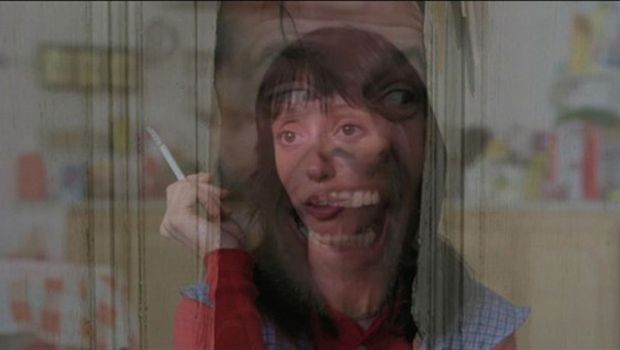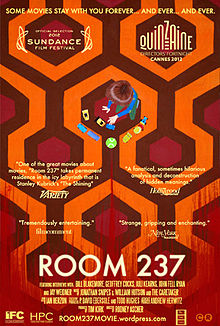Directed by Rodney Ascher
USA, 2012
A blessing and curse of being human is that we grasp for meaning in all things. If something is not spelled out for us directly, we have to get to the bottom of it, our curiosity unable to be sated until we’ve gotten to the bottom of an investigation. This unflagging obsession manifests in all aspects of modern society, from debates of modern medicine to pop culture. In the latter, topics are infinite: what did the ending of Lost really mean? Are there hidden clues to a greater, subtly woven-in argument in a new film from an auteur like Paul Thomas Anderson? We look for the hidden, the submerged, so often that we sometimes forget (or choose to ignore) how crazy our theories end up sounding. Such is the foundation of the hypnotically entertaining documentary Room 237, which posits that Stanley Kubrick’s 1980 classic The Shining is really about the Holocaust. Or it’s about him having helped fake the moon landing in 1969. Or it’s about the white man conquering the Native American. Or a host of other things.
Director Rodney Ascher assembles five conspiracy theorists, all of whom have watched The Shining multiple times over the past three decades and are absolutely certain that they know what Kubrick was really trying to say with this fascinating, ambiguous, impenetrable horror film. And to be sure, there are many questions left unanswered in that iconic film, either within the movie or throughout its production. Why did Kubrick change the infamous room number from 217, as in Stephen King’s novel, to 237? And what of the choices he makes in the final act, revealing ghosts through multiple points of view? And what is the significance of the Calumet baking powder placed in strategic areas of the Overlook Hotel’s walk-in pantry? It’s more esoteric minutiae that the five theorists in Room 237, heard via voiceover but never shown, pore over with a fine-tooth comb, often to the point of baffling anyone watching the film.
Like Kubrick’s other classics, you can watch The Shining a hundred times or even a thousand times and find something new, see a small detail you may have missed before. In some ways, though, it’s Kubrick’s well-known perfectionist streak that has fueled a lot of the frequently nutty theories on display in Room 237. For example, at a pivotal moment in The Shining, Jack Torrance (Jack Nicholson) and his wife Wendy (Shelley Duvall) are discussing the weather; more accurately, Wendy is trying to engage Jack in small talk but he’s trying to act busy via his many unexplored writing projects. In one shot, we see a chair behind Jack against the wall. The next time Kubrick cuts to Jack, the chair is gone, though the rest of the set design is the same. What’s the meaning? Many of the speakers acknowledge that, sure, such minor instances could be continuity errors, but for them, Stanley Kubrick is not a man who made continuity errors. He did not make mistakes, they presume. So automatically, they choose to ignore Occam’s Razor, the notion that the simplest explanation for a problem is often the correct one.
On the face of it, saying that The Shining is a coded explanation for Kubrick having staged the moon landing–with 2001: A Space Odyssey as a research project, of course–is ridiculous. In Room 237, the theorists don’t so much make convincing arguments to sway the audience as much as they prove that it’s possible to think too hard about even the greatest of movies if all you’re looking for is a definitive answer where none exists. What makes art so special is that we can debate it at its finest, feverishly and endlessly. Some films don’t need or deserve intense mental exploration, but everything Stanley Kubrick made earns its status as something worth sparking critical conversation. Room 237 is less about standard-issue criticism and more about a neverending quest to theoretical validation, one that can never be achieved. Kubrick having passed away nearly 15 years ago, we’ll never know if The Shining really was about the Holocaust or any of the other theories. We can guess that the people highlighted here are crackpots, or we can rewatch The Shining, see all the clues they spotted and begin to wonder ourselves.
But of course, even if Stanley Kubrick was still alive, we’d have no idea if the theories in Room 237 were what he intended. Kubrick was well-known as a reclusive filmmaker, able to make some of the most memorable, iconic films in Western cinema without having to compromise his principles. He often trafficked in the unknowable, works of art that cannot easily be pinned down. Room 237 is a truly excellent examination of five people, representative of so many more, who won’t be satisfied with not knowing, not being sure that The Shining has meaning beyond being an intense horror film. Maybe they find the surface-level story disappointing, or maybe they just expect there to be more than what’s on the screen. Their theories may sound hackneyed, but they’re a microcosm of modern popular culture, where we can’t help but analyze new works to death. It’s easy to scoff at the men and woman in Room 237, until we admit that we’re guilty of such overanalytic thought. If any one filmmaker deserved such scouring, it’s Kubrick. The topics brought up here don’t get resolved–how could they ever?–but the debate over what The Shining meant (or if it meant anything at all) will rage on for time immemorial.
— Josh Spiegel




